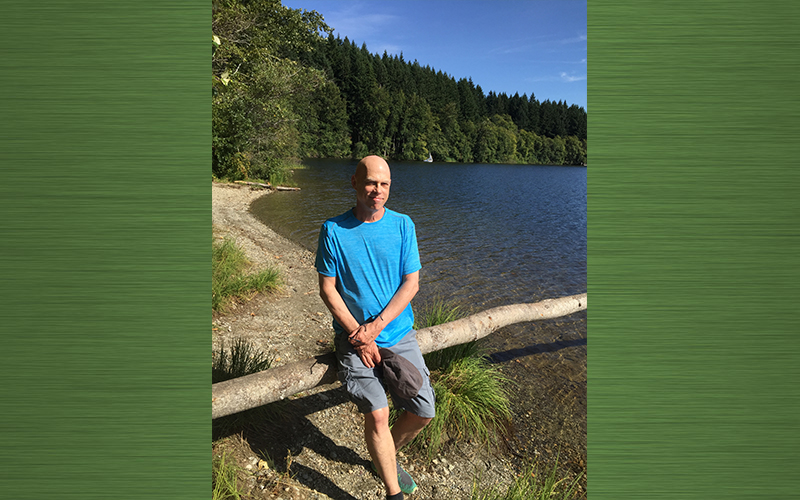
Transferred to UW Medical Center following a heart attack, Rob was diagnosed with a serious blockage in his right coronary artery. Two stents were placed to open the arteries and maintain circulation to Rob’s heart tissue. The heart attack and following procedure were a shocking turn of events for 65-year old Rob and his family since he exercised regularly, ate well and had always been in good health.
After a few weeks of recovery, Rob was anxious to get moving again. But how could he rebuild physical endurance and strength safely after experiencing a life threatening, cardiac event? Rob’s cardiologist recommended Valley Medical Center’s Cardiac Rehabilitation program.
This article was originally published in 2018. We reached out to Rob to see how he’s doing 5 years later: “There were a lot of benefits to doing cardiac rehabilitation, but the main thing for me was learning that I could safely exercise on my own without fear of harming myself. The monitoring during the cardiac rehabilitation sessions gave me the confidence that I can push myself. And now – five years later – I am in very good health and feel no restrictions about my ability to exercise and do other lifestyle activities.” – Rob, February 2024
At Valley’s Cardiac Rehabilitation, cardiac-trained nurses and exercise specialists monitored patients’ hearts to help them safely start or return to an exercise program. They customize a well-rounded, 12-week, medically-supervised plan tailored to each patient’s fitness level, medical conditions and interests. Strength training and stretching are part of most plans, as is learning how to manage symptoms while safely increasing the heart rate to higher levels. Patients also learn about stress management and reducing other risks to improve their well-being and prevent a cardiac event in the future.
For Rob, having his heart rate and rhythm monitored at Cardiac Rehabilitation while being guided by experts gave him peace of mind about the safety of reconstructing his fitness. “Knowing that the exercise specialists were watching me progress, reassured me that it was okay to increase my intensity over the weeks,” says Rob.
It’s been nearly a year since he had his heart attack, and now Rob enjoys taking daily walks again with his wife and going to the YMCA to lift weights and use the pool. Today when he climbs the steep hills in his neighborhood and he feels heart rate pick up and his breathing get faster, he’s confident his cardiovascular system is responding just as it should—and that it feels great to be alive!
What You Should Know about Valley’s Cardiac Rehabilitation Program
When should patients come to Cardiac Rehabilitation?
- Within 12 months of a heart attack (myocardial infarction)
- Any time after diagnosis and/or treatment of a:
- Heart condition, such as coronary artery disease (CAD), angina or heart failure
- Heart procedure or surgery, including coronary artery bypass graft (CABG) surgery, percutaneous coronary intervention (PCI, including coronary or balloon angioplasty and stenting), valve replacement, a pacemaker or implantable cardioverter defibrillator (ICD)
Why go to Valley’s Cardiac Rehabilitation program rather than exercising at home or going to a gym?
Patient heart rates are monitored by EKG to help them progress in their program, as well as to ensure there are no abnormalities in their rhythms. A cardiologist reviews the patient’s progress notes monthly to ensure patients are on track with no other medical concerns. Often blood pressure and cholesterol medications can be reduced as patients practice healthy lifestyle behaviors more regularly. Because Valley’s Cardiac Rehabilitation program is located on the hospital campus, care teams are in place to respond quickly in the unlikely event of an emergency while participating in the program.
What are some of the benefits of completing a cardiac rehabilitation program?
- Lower your risk of a future cardiac event
- Eat better
- Lose weight
- Return to work
- Improve outlook on life
- Engage in daily activities you might have missed
Does insurance cover cardiac rehabilitation?
Medicare and most insurance plans cover payment for cardiac rehabilitation for the conditions listed above. Valley’s Cardiac Rehabilitation team will check with a patient’s insurance plan on their behalf and answer any questions patients may have.
Can patients continue exercising at Valley after completing the 12-week, cardiac rehabilitation program?
Yes! Patients can transition to the Lifestyle Medicine’s Lifestyle 365 programs available at Valley’s Fitness Center. With the same equipment as the cardiac rehabilitation program, Valley’s Fitness Center staff can help patients continue to progress from where they finished with cardiac rehabilitation.
For more information about Valley’s Cardiac Rehabilitation program, visit valleymed.org/cardiacrehab or call 425.690.3516.

